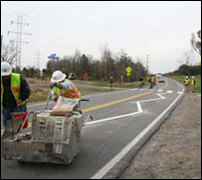 Forty-five minutes west of Pink, Inc, world headquarters — in the once bucolic, now (sorta) booming land of Loudon County — the Virginia Department of Transportation is rolling out a cool experiment.
Forty-five minutes west of Pink, Inc, world headquarters — in the once bucolic, now (sorta) booming land of Loudon County — the Virginia Department of Transportation is rolling out a cool experiment.
Instead of painting perfectly straight white lines down the center of some roads, VDOT is using zig-zag lines. Huh? The crooked lines look a bit like the handiwork of an inebriated road crew, but they have a purpose.
As a VDOT spokesperson told WTOP.com,“It is a low cost strategy to get motorists to slow down as they approach the bike trail and pedestrian path. While at first motorists may be a little disoriented, the main point is to get them to pay attention and slow down through that area.”
Interesting idea. It’s like a two-dimensional speed bump. And if it works, I bet we’ll be seeing more. (HT: Chris Cavallerano)
Very genius… if it works that is. I think I might have this wild urge to follow the path with my car, thereby running haphazardly out of control killing both myself and any would be pedestrian. I hope I’m not like most people.
I agree… I personally don’t believe this is the best idea that they have come up with. If anything, they should have tried a different color. I don’t think this will work espcially in harsh conditions. If the weather is horrendous and you must strictly follow the lines, how is that going to work? There may just be a few accidents along the way until they adjust their strategy of slowing drivers down.
I agree with Brianna and James. I think that the reasoning behind it is important; so many deaths and injuries can be avoided if drivers slow down. But, I’m not sure changing the lines on roads is the best way to go about it. Even if the lines don’t cause drivers to slow down, they will most likely just cause confusion and accidents along the way. The lines will probably get the attention of most drivers; but what if they’re paying too much attention to the strange new road lines and not enough attention to the pedestrians or hazards that are up ahead?
Driving is a spatial, right-brainer job.
That’s the likely reason why using a hands-free cell phone doesn’t reduce the odds that you will be in a cell phone related accident. The distraction isn’t that you are using your hands it’s that you are talking in left-brainer mode; using the wrong hemisphere for the job of driving. People are doing the same sort of left-brain thingy while they are looking at this picture of a zigzag white line being painted on a road. The written words that accompany the picture, in particular the words “zig-zag lines”, have helped to distract people from seeing the big picture.
Look at the whole picture in relation to what you know about driving.
Do you see that the road already has a line of a different color painted down its middle? Given the scale in the picture, at what speed would you have to be traveling to follow the zigzag white line with your car? In poor weather conditions when you are using a line in the road to navigate, where do you put your car in relation to the line? If the road you are driving on has two different colored lines painted on it what should you do? Is that road crew done painting that line? What does the completed line look like? Are the two pedestrians standing off the road to the right going to enter the crosswalk? What about the oncoming traffic, what are oncoming cars likely to do? Why? If you had to describe in writing each and every piece of information presented in this picture how many words would it take? Did you notice the power line tower? Should it be included in your written description? Do you think that most people would first see all that the picture has to say or would they mostly focus on the words in the posting that accompany the picture? Which is more important to understanding how the zigzag white line might work on a roadway, the picture or the words that accompany the picture? What brain hemisphere would be the best choice to use to figure it all out?
The big picture has lots of information being presented simultaneously and it’s about driving but some written words may have distracted you.
Do you now understand how a hands-free cell phone will not reduce your odds of being in a cell phone related accident?
This is a great idea! I can see where this may have flaws. However, our current statergy is not working, so we need to focus on new methods that will get cars too slow down and force drivers to be more alert, I strongly applaud VDOT on this and think its a wonderful idea.
It’s interesting to hear about this idea as an experiment in emotionally intelligent design. You may find that there is already proof that the idea works, because in Australia the zig-zag has been used to indicate an upcoming pedestrian crossing for quite a while. I remember it being in my driver’s handbook when I was learning to drive in 2000.
I think, rather than disorienting motorists, it is just the use of a vivid symbol used in the right place. Often I am more attuned to speed limits painted on the road rather than on signs because there are so many signs and distractions on the street that it can be overwhelming, and motorists inevitably filter out a lot of information and just focus on the road and traffic.